|
Starting
with scattered outcrops just south of Tucson and on the Southern
ends of Gila County, the Abrigo extends down to Arizona's border
on its southern most named extensions. Upper Middle Cambrian
in age, this represents a continuation in both extent and time
for the northern Tonto Group, but is present only in southern
Arizona. Preservation is similar to the Muav limestone and Bright
Angel shale in the Grand Canyon, but the exposed areas are more
accessible as they are visible in road cuts and in rolling hills.
Fauna includes many fragmentary trilobites, Hyalithids, inarticulate
brachs, trace fossils, a few rare echinoderms and peltmazoans.
Subsections:
Click on thumnail
to go to sub section:
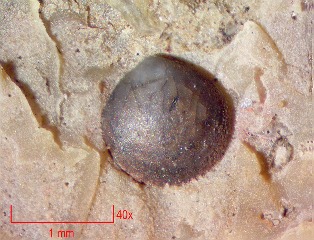 This is the typical size of brachs during
Cambrian times.
This is the typical size of brachs during
Cambrian times.
|
Brachipods
are small but very important fossils in the Abrigo, these tiny
mostly phosphatized fossils appear as tiny black or white dots
in the limestone matrix on split surfaces. |
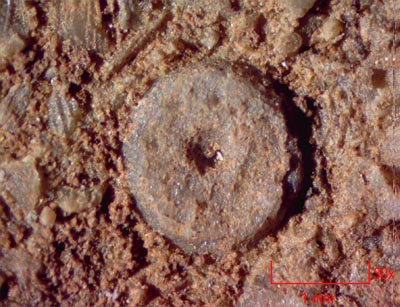 Only a few isolated crinoid columnals were
found. They are quite small, and hard to see.
Only a few isolated crinoid columnals were
found. They are quite small, and hard to see.
|
Crinoids / Stemmed Pelmatozoans
While no complete specimens were found, we did find a few
very rare enchinoderm like fossils.
|
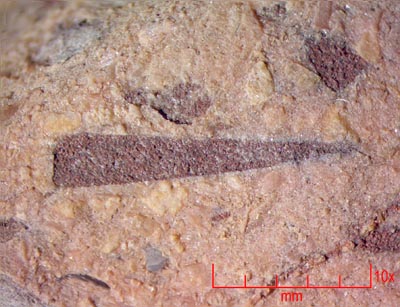 These primitive mollusks can be found
in both limestones and shales!
These primitive mollusks can be found
in both limestones and shales!
|
Hyalithids
are small toothpick sized early extinct mollusks, with small
thin cone shaped shells. We found them occasionally in with other
fossils, and at one site south of Tucson, slabs of hundreds of
them. The soft parts of Hyalitids have never been found, so we
cannot be certain of thier exact affinities. |
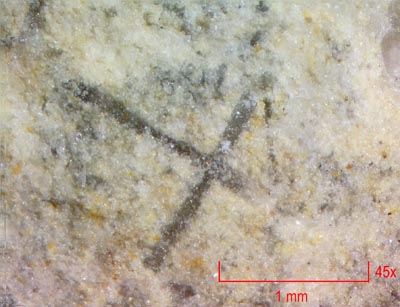 A few slabs revealed these tiny sponge
spicules upon close microscopic examination.
A few slabs revealed these tiny sponge
spicules upon close microscopic examination.
|
Sponges
were a bit rare in our searches. We found a few slabs containing
spicules as seen here, but little else as far as body fossils. |
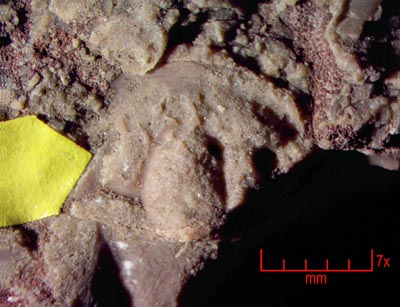 While we had never found a complete specimen,
the prodominant fossil in the Abrigo limestone
was trilobite hash. (Trilo-bits?)
While we had never found a complete specimen,
the prodominant fossil in the Abrigo limestone
was trilobite hash. (Trilo-bits?)
|
Trilobites
were found commonly as the dominant fossils at many sites. Rarely
articulated, trilobite hash was the most common type of preservation.
Most of the species were not identifiable from the ground up
hash, only a few could be decerned down to the Genus level. |
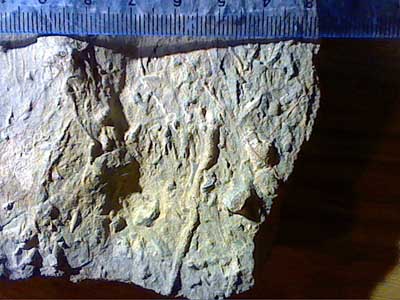 Both Limestone and Shale members
especially had abundant trace fossils.
Both Limestone and Shale members
especially had abundant trace fossils.
|
Trace
Fossils are the most common fossils found in any of type in the
Cambrian of Arizona. We found a large number of them in our surveys,
and here we document some of them. While we never found a single
trilobite trackway, many other types were seen. |
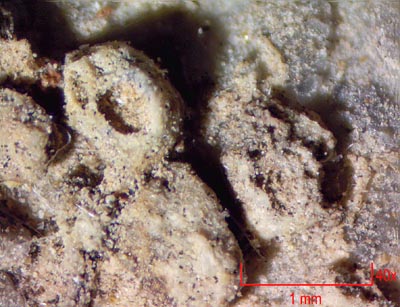 Several biogenic fossils of unknown affinity
were found under the scope.
Several biogenic fossils of unknown affinity
were found under the scope.
|
Enigmatic
Fossils are those which we have not been able to identify yet.
The Cambrian is full of such types, and in formations such as
the Abrigo which have not been well documented, we found quite
a few. |
|